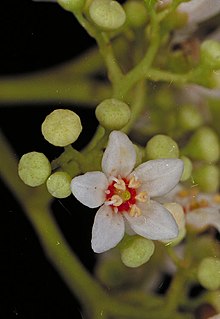Flindersia ifflana
Flindersia ifflana, commonly known as hickory ash or Cairns hickory,[2] is a species of tree in the family Rutaceae and is native to Papua New Guinea and Queensland. It has pinnate leaves with between four and twelve egg-shaped to elliptical leaflets, panicles of white or cream-coloured flowers and woody fruit studded with rough points.
| Hickory ash | |
|---|---|
 | |
| Scientific classification | |
| Kingdom: | Plantae |
| Clade: | Tracheophytes |
| Clade: | Angiosperms |
| Clade: | Eudicots |
| Clade: | Rosids |
| Order: | Sapindales |
| Family: | Rutaceae |
| Genus: | Flindersia |
| Species: | F. ifflana |
| Binomial name | |
| Flindersia ifflana | |
| Synonyms[1] | |
| |

Description
Flindersia ifflana is a tree that typically grows to a height of 35 m (115 ft) and has thick fissured bark on old trees. The leaves are arranged in opposite pairs and are pinnate, 130–340 mm (5.1–13.4 in) long with four to twelve egg-shaped to elliptical leaflets that are 60–135 mm (2.4–5.3 in) long and 25–55 mm (0.98–2.17 in) wide on petiolules 4–10 mm (0.16–0.39 in) long. The flowers are arranged in panicles 100–250 mm (3.9–9.8 in) long, with at least a few male-only flowers. The sepals are about 1 mm (0.039 in) long and the petals are cream-coloured or white, 2–2.5 mm (0.079–0.098 in) long. Flowering occurs from October to March and the fruit is a woody capsule 32–55 mm (1.3–2.2 in) long, containing seeds that are 27–33 mm (1.1–1.3 in) long.[2][3]
Taxonomy
Flindersia ifflana was first formally described in 1877 by Ferdinand von Mueller in Fragmenta phytographiae Australiae from specimens collected by Walter Hill near Trinity Bay.[4][5]
Distribution and habitat
Hickory ash grows in rainforest and is found in Papua New Guinea and in Queensland where it oocurs at altitudes between 30 and 900 m (98 and 2,953 ft) from Cape Grenville to near Atherton.[2]
References
- "Flindersia ifflana". Australian Plant Census. Retrieved 17 July 2020.
- Hartley, Thomas G.; Wilson, Annette J.G. (ed.) (2013). Flora of Australia (Volume 26). Canberra: Australian Biological Resources Study. p. 71. Retrieved 17 July 2020.CS1 maint: extra text: authors list (link)
- "Flindersia ifflana". Australian Tropical Rainforest Plants - Australian National botanic Gardens. Retrieved 16 July 2020.
- "Flindersia ifflana". APNI. Retrieved 17 July 2020.
- von Mueller, Ferdinand (1877). Fragmenta phytographiae Australiae (Volume 10). Melbourne: Victorian Government Printer. pp. 94–95. Retrieved 17 July 2020.